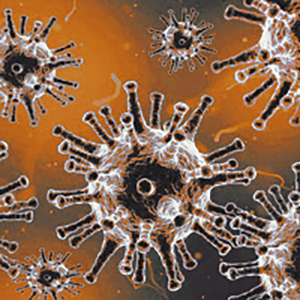Prognostic factors for SARS-CoV-2 nasopharyngeal swab negativity: a multicentric study

Submitted: 21 November 2022
Accepted: 31 December 2022
Published: 31 December 2022
Accepted: 31 December 2022
Abstract Views: 1016
PDF: 182
HTML: 12
HTML: 12
Publisher's note
All claims expressed in this article are solely those of the authors and do not necessarily represent those of their affiliated organizations, or those of the publisher, the editors and the reviewers. Any product that may be evaluated in this article or claim that may be made by its manufacturer is not guaranteed or endorsed by the publisher.
All claims expressed in this article are solely those of the authors and do not necessarily represent those of their affiliated organizations, or those of the publisher, the editors and the reviewers. Any product that may be evaluated in this article or claim that may be made by its manufacturer is not guaranteed or endorsed by the publisher.
Similar Articles
- Gabriella Nucera, Francesco Chirico, Valentina Raffaelli, Pietro Marino, Current challenges in COVID-19 diagnosis: a narrative review and implications for clinical practice , Italian Journal of Medicine: Vol. 15 No. 3 (2021)
- Elena Garlatti Costa, Cesare Mazzaro, Alessandro Grembiale, Alessandro Berto, Rita De Rosa, Silvia Grazioli, Maurizio Tonizzo, HIV, HCV and SARS-CoV-2: friends or foes? A case report , Italian Journal of Medicine: Vol. 15 No. 3 (2021)
- Sirio Fiorino, Andrea Carusi, Alessandro Zappi, Fabio Tateo, Luca Peruzzo, Melissa Zanardi, Francesco Savelli, Giulia Di Marzio, Silvia Cesaretti, Francesca Dazzani, Raffaella Francesconi , Paolo Leandri , Gianfranco Tortorici , Susanna Vicari , Dora Melucci, Federico Lari, Characteristics, comorbidities and laboratory measures associated with disease severity and poor prognosis in young and elderly patients with COVID-19 admitted to medical wards in Emilia-Romagna region, Italy: a multicentre retrospective study , Italian Journal of Medicine: Vol. 17 No. 1 (2023)
- Tiziana Ciarambino, Alfonso Ilardi, Orazio Valerio Giannico, Ada Maffettone, Filippina Ciaburri, Venere Delli Paoli, Andrea Fontanella, Paolo Tirelli, Carolina Bologna, Fernando Gallucci, Mario Visconti, Domenico Caruso, Maria Amitrano, Mauro Giordano, Maria D'Avino, Gender differences in COVID-19 patients: a regional survey among physicians of Internal Medicine Wards , Italian Journal of Medicine: Vol. 15 No. 3 (2021)
- Benedetta Pennella, Francesca Rotunno, Martina Mercuri, Marco Guerci, Mauro Molteni, Marta Biancucci, Clelia Berton, Francesca Troian, Paolo Maria Tripodi, Alessia Gilio, Antea Milano, Daniela Dalla Gasperina, Francesco Dentali, Aldo Bonaventura, Andrea Maria Maresca, Clinical factors affecting short- and long-term mortality in older patients with COVID-19: a retrospective cohort study , Italian Journal of Medicine: Vol. 18 No. 1 (2024)
- Filomena Pietrantonio, Francesco Rosiello, Matteo Ruggeri, Maria Sofia Cattaruzza, Antonio Vinci, Margherita Lordi, Enrica Cipriano, Prevention is better than healing. Clinical and economic implications of oral antiviral agents in COVID-19: a prospective study , Italian Journal of Medicine: Vol. 18 No. 2 (2024)
- Manuel Monti, Tiziana Ciarambino, Filomena Pietrantonio, Sara Rotunno, Alessandra Fiorentini, Rosalba Cipriani, Giuseppe Campagna, Giuseppe Straface, Eleonora Pistella, Mauro Giordano, Orazio Valerio Giannico, Roberto Marchetti, Federica Lorenzi, Francesco Rosiello, CO-St (COVID 19-study): sex differences in the treatment of COVID-19 , Italian Journal of Medicine: Vol. 19 No. 1 (2025)
- Chiara Vassallo, Francesca Pupo, Luca Marri, Chiara Schiavi, Francesca Giusti, Monica Greco, Simone Negrini, Raffaele De Palma, Andrea Guastalla, Recurrence of COVID-19 related symptoms and viral detection in a patient discharged after complete recovery and test negativization , Italian Journal of Medicine: Vol. 15 No. 1 (2021)
- David Micarelli, Gianluca Santoboni, Michela Tarnani, Claudio Angrisani, Alessandra Fiorentini, Carlo Meschini, A case of hemolytic anemia associated with interstitial lung disease, arthralgia and fever caused by Mycoplasma pneumoniae , Italian Journal of Medicine: Vol. 15 No. 2 (2021)
- Elia Rigamonti, Tanja Fusi-Schmidhauser, Gianluca Argentieri, Pietro Gianella, Differential diagnoses in COVID-19 pandemic: a retrospective descriptive study , Italian Journal of Medicine: Vol. 15 No. 1 (2021)
You may also start an advanced similarity search for this article.

 https://doi.org/10.4081/itjm.2022.1552
https://doi.org/10.4081/itjm.2022.1552




